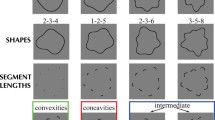Abstract
What is the relation between Kanizsa's bias towards convexity and the Gestaltists' demonstrations that perceptual organization obeys a principle of pragnänz, or simplicity? Why should either kind of bias exist? Textbook accounts assign no functional role for these biases. Geon theory (Biederman 1987) proposes that we can understand these biases in terms of fundamental processes by which complex objects are decomposed into convex (or singly concave) regions at points of matched cusps according to the transversality regularity (Hoffman and Richards 1985). Such decomposition yields simple, convex parts segmented between the concavities. A shape that contains concavities is generally regarded as complex insofar as it can be decomposed into the regions, or parts, between the concavities. It is these simple parts that are the stable elements of shape, not the whole object. In fact, geon theory leads to the expectation that shape recognition proceeds most efficiently when the parts are good (in the pragnänz sense) but the object is bad!
Similar content being viewed by others
REFERENCES
Biederman, I.: 1987. 'Recognition-by-components: A Theory of Human Image Understanding', Psychological Review 94, 115–147.
Biederman, I.: 1995. 'Visual Object Recognition', in S. M. Kosslyn and D. N. Osherson (eds.), An Invitation to Cognitive Science, 2nd edition, Volume 2, Visual Cognition. MIT Press, Chapter 4, pp. 121–165.
Biederman, I. And M. Bar: 1999. 'One-shot Viewpoint Invariance in Matching Novel Objects', Vision Research 39, 2885–2899.
Biederman, I., H. J. Hilton and J. E. Hummel: 1991. 'Pattern Goodness and Pattern Recognition', in J. R. Pomerantz and G. R. Lockhead (eds.), The Perception of Structure (Chapter 5, pp. 73–95). Washington, D.C.: APA.
Biederman, I., and P. Kalocsai: 1997. 'Neurocomputational Bases of Object and Face Recognition', Philosophical Transactions of the Royal Society London: Biological Sciences 352, 1203–1219.
Biederman, I. and S. Subramaniam: 1997. 'Predicting the Shape Similarity of Objects without Distinguishing Viewpoint Invariant Properties (VIPs) or Parts', Investigative Ophthalmology & Visual Science 38, 998.
Buffart, H. E. and E. L. J. Leeuwenberg: 1983. 'Structural Information Theory', in H. G. Geisler, J. F. J. M. Buffart, E. L. J. Leeuwenberg and V. Sarris (eds.), Modern issues in perception (pp. 48–71). Berlin: VEB Deutscher Verlag der Wissenschaften.
Fiser, J., I. Biederman and E. E. Cooper: 1996. 'To What Extent can Matching Algorithms Based on Direct Outputs of Spatial Filters Account for Human Shape Recognition?', Spatial Vision 10, 237–271.
Garner, W. R.: 1974. The processing of information and structure. Potomac, MD: Erlbaum.
Gibson, E. J. and H. Levin: 1975. The psychology of reading. Cambridge, MA: MIT Press.
Ginsburg, A. P.: 1986. 'Spatial Filtering and Visual Form Perception', in K. R. Boff, L. Kaufman and J. P. Thomas (eds.), Handbook of perception and human performance (Vol. 2, Chapter 36, pp. 36–1 to 36–41). New York: Wiley.
Hoffman, D. D.: 1998. Visual Intelligence. New York: Norton.
Hoffman, D. D. and W. Richards: 1985. Parts of recognition. Cognition 18, 65–96.
Hummel, J. E. and I. Biederman: (In press). 'Dynamic Binding in a Neural Network for Shape Recognition', Psychological Review 99, 480–517.
Kanizsa, G.: 1979. Organization in vision: essays on gestalt perception. New York: Praeger.
Kayeart, G., I. Biederman and R. Vogels: 2003. 'A Systematic Study of Shape Tuning in Macaque Inferior Temporal Cortex', Journal of Neuroscience, in press.
Kimia, B. B., A. Tannenbaum and S. W. Zucker: 1989. 'Conservation Laws and the Evolution of Shape', Paper presented at the SPIE Meetings, Falmouth, MA.
Kobatake, E. and K. Tanaka: 1994. 'Neuronal Selectivities to Complex Object Features in the Ventral Visual Pathway of the Macaque Cerebral Cortex', Journal of Neurophysiology 71, 856–867.
Koffka, K.: 1963. Principles of Gestalt psychology. New York: Harcourt, Brace & World. (Original work published, 1935).
Lades, M., J. C. VortbrĄggen, J. Buhmann, J. Lange, C. von der Malsburg, R. P. Würtz and W. Konen: 1993. 'Distortion Invariant Object Recognition in the Dynamic Link Architecture', IEEE Transactions on Computers 42, 300–311.
Li, W. and C. D. Gilbert: 2002. 'Global Contour Saliency and Local Colinear Interactions', Journal of Neurophysiology 88, 2846–2856.
Lowe, D.: 1984. 'Perceptual Organization and Visual Recognition', Unpublished doctoral dissertation, Department of Computer Science, Stanford University.
Mangini, M. C. and I. Biederman: 1999. 'Do Objects with Many Parts Incur Greater Attentional Costs than Objects with Few Pparts?', Poster presented at the 7th Annual Workshop on Object Perception and Memory. Los Angeles. Nov.
Marr, D.: 1977. Vision. San Francisco: Freeman.
Nalwa, V. S.: 1988. 'Line-drawing Interpretation: A Mathematical Perspective', International Journal of Computer Vision 2, 103–124.
Nederhouser, M., M. C. Mangini and I. Biederman: 2002. The matching of smooth blobby objects-but not faces-is invariant to differences in contrast polarity for both na<ve and expert subjects. Poster presented at the 2nd Annual Meeting of the Vision Sciences Society, Sarasota, FL., May.
Palmer, S. E.: 1999. Vision Science: Photons to Phenomenology. Cambridge, MA: MIT Press.
Rolls, E. T. and G. Deco: 2002. Computational Neuroscience of Vision. Oxford.
Thorpe, S. J. and M. Fabre-Thorpe: 2001. 'Seeking Categories in the Brain', Science 291, 260–263.
Tsunoda, K., Y. Yamane, M. Nishizaki and M. Tanifuji: 2001. 'Complex Objects are Represented in Macaque Inferotemporal Cortex by the Combination of Feature Columns', Nature Neuroscience 4, 832–838.
van der Helm, P.: 1988. Accessibility and simplicity of visual structures. Unpublished doctoral dissertation, The Catholic University of Nijmegen, The Netherlands.
Vaina, L. M. and S. D. Zlateva: 1990. 'The Largest Convex Patches: A Boundary-based Method for Obtaining Object Parts', Biological Cybernetics 62, 225–236.
Vogels, R., I. Biederman, M. Bar and A. Lorincz: 2001. 'Inferior Temporal Neurons Show Greater Sensitivity to Nonaccidental than Metric Differences', Journal of Cognitive Neuroscience 13, 444–453.
Rights and permissions
About this article
Cite this article
Biederman, I. On the Relation between Kanizsa's Bias Towards Convexity and the Gestaltists Prägnanz from the Perspective of Current in Shape Recognition. Axiomathes 13, 329–346 (2003). https://doi.org/10.1023/B:AXIO.0000007318.67978.1c
Issue Date:
DOI: https://doi.org/10.1023/B:AXIO.0000007318.67978.1c




